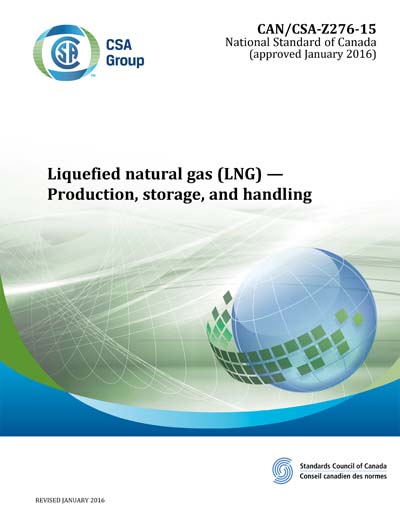Historical
CSA Z276-2015
Z276-15 - Liquefied natural gas (LNG) - Production, storage, and handling
Preface
This is the tenth edition of CSA Z276, Liquefied natural gas (LNG) - Production, storage, and handling. It supersedes the previous editions published in 2011, 2007, 2001, 1994, 1989, 1981, 1978, 1973, and 1972. This Standard contains basic reference data relating to design, supplemented by specific requirements, where necessary, to establish a uniform interpretation of the design requirements. The main difference from the previous edition is the: a) addition of requirements for membrane tanks; and b) addition of requirements for mobile LNG fuelling stations.Introduction
This Standard establishes essential requirements and minimum standards for the design, installation, and safe operation of liquefied natural gas (LNG) facilities. It is not a design handbook, and competent engineering judgment is necessary for its proper use.Scope
1.1 This Standard applies to the a) design; b) location; c) construction; d) operation; and e) maintenance of facilities for the liquefaction of natural gas and facilities for the storage, vaporization, transfer, handling, and truck transport of LNG. It also contains requirements for the training of personnel. 1.2 For facilities that load or unload LNG from a marine vessel, this Standard contains requirements for the interconnecting piping between the loading/unloading arm flange and the storage tank(s), and other piping and appurtenances on the pier or jetty itself. 1.3 This Standard applies to all containers for the storage of LNG, including those with insulation systems applying a vacuum. 1.4 This Standard does not apply to frozen ground containers. 1.5 This Standard includes non-mandatory guidelines for a) small LNG facilities (see the definition of small facility in Clause 3 and see Annex B); and b) LNG vehicle fuelling stations employed for fleet and public LNG vehicle fuel dispensing operations (see the definition of fuelling station in Clause D.2 and see Annex D). 1.6 This Standard does not apply to the following: a) the transportation of refrigerants by any means; b) the transportation of LNG by railcar or marine vessel; c) the transportation of LNG or regasified LNG by pipeline beyond the facility boundary, except as specified in Clause 1.2; and d) facilities designed to allow the use of LNG as a fuel for railroad locomotives, or marine vessels. 1.7 All references to pressure throughout this Standard refer to gauge pressures unless otherwise specified. 1.8 All pipe sizes refer to nominal pipe sizes (NPS). 1.9 The values given in SI units are the units of record for the purposes of this Standard. The values given in parentheses are for information and comparison only. 1.10 In this Standard, shall is used to express a requirement, i.e., a provision that the user is obliged to satisfy in order to comply with the standard; should is used to express a recommendation or that which is advised but not required; and may is used to express an option or that which is permissible within the limits of the standard. Notes accompanying clauses do not include requirements or alternative requirements; the purpose of a note accompanying a clause is to separate from the text explanatory or informative material. Notes to tables and figures are considered part of the table or figure and may be written as requirements. Annexes are designated normative (mandatory) or informative (nonmandatory) to define their application.Content Provider
CSA America, Inc. [csa]






